Aug
22
2013

What does “Under the Sun” mean in Ecclesiastes?
Genesis 1 tells us that the purpose of the sun, moon and stars is to act as kingly governors of the physical realm. They were created at the centre of the Creation Week (Day 4), before Man, yet Man was not to bow down to them.
And beware lest you raise your eyes to heaven, and when you see the sun and the moon and the stars, all the host of heaven, you be drawn away and bow down to them and serve them, things that the Lord your God has allotted to all the peoples under the whole heaven. (Deuteronomy 4:19)
The reason for this is that although Genesis 1 presents Man as part of the physical order, Genesis 2 moves him beyond this to a social order. When Adam perceives that he is without a mate, he is “bowed down,” physically humbled, that Woman might be constructed. Adam’s order would not be like that of the animals. His rule from its very beginning would be “sacrificial.” Men would not bow to the stars (or to idols) but to each other, because all men are images, reflections, of God. Adam was to subdue the physical order and bring it into submission, and yet submit to other men. The sinful reverse of this is the worship of the physical order (which is yet inherent in the scientism of our own age) and the tyrannical subjugation of our fellow men, which is exactly what happened in Genesis 3. Physical, Social, Ethical.
Continue reading
Comments Off | tags: AD70, Covenant Theology, Lampstand, Revelation, Solomon, Tabernacle | posted in Bible Matrix, Biblical Theology, Q&A, The Last Days
Jul
23
2013
 Bible Symbols in Pacific Rim
Bible Symbols in Pacific Rim
“Then I saw another mighty angel coming down from heaven, wrapped in a cloud, with a rainbow over his head, and his face was like the sun, and his legs like pillars of fire. He had a little scroll open in his hand. And he set his right foot on the sea, and his left foot on the land, and called out with a loud voice, like a lion roaring. When he called out, the seven thunders sounded.” (Revelation 10:1-3)
Just a few notes on Pacific Rim, a movie which we enjoyed very much. It’s one of those films where you know your strings are being pulled, but they are doing it so well you don’t mind at all. There are some interesting deviations from the Hollywood formula, and they are worth identifying.
(Oh, and River says there’s spoilers ahead.)
Continue reading
2 comments | tags: Daniel, Postmillennialism, Revelation, Tabernacle | posted in Biblical Theology, The Last Days
Jul
19
2013
“So, perhaps the best conclusion is that John was not looking for encouragement, but giving encouragement. In effect, he was saying, ‘Get on with it, cousin!’”
The nature of the texts of the Bible is just like the spoken words God gave to Adam. A great deal remained unsaid, and Adam was to “read between the lines” based upon God’s revealed character as his Father. However, Adam let somebody else fill in the gaps with some conflicting information about God’s character, somebody who was very likely jealous of Adam’s commission and had an ax to grind (and even here, we are left to fill in the gaps as to Satan’s motive based upon later scriptures!)
Continue reading
7 comments | tags: Albert Garlando, Bible Matrix III, John the Baptist, Literary Structure, Luke, Tabernacle | posted in Bible Matrix, Biblical Theology, Q&A
Jul
16
2013
 “When Moses slew the Egyptian, he was doing the will of God but not with the power of God.”
“When Moses slew the Egyptian, he was doing the will of God but not with the power of God.”
Numbers 12:3 says that Moses was the meekest man “on the face of the ground [adamah].”
Psalm 37:11 says the meek will inherit the Land [eretz] and delight in abundant prosperity.
Isaiah 11:4 says that
with righteousness [God] shall judge the poor,
and decide with equity for the meek of the Land;
and he shall strike the Land with the rod of his mouth,
and with the breath of his lips she shall kill the wicked.
Firstly, what is meekness? And secondly, why is it connected to “face of the ground” (Adam), or Land?
This post has been slain and resurrected for inclusion in my 2015 book of essays, Inquietude.
Continue reading
Comments Off | tags: Ascension, Firstfruits, Genesis, Herod, Isaiah, James Jordan, Matthew, Moses, Pharaoh, Tabernacle | posted in Bible Matrix, Biblical Theology, Christian Life, Ethics, Quotes, The Last Days
May
18
2013
or A Ripsnorter Ritual
 Ritual is powerful stuff. Much of modern evangelicalism prides itself in rejecting liturgy and being “open to the Spirit,” and then turns this “openness” into an uninspired (and very uninspiring) human formula, in place of the inspired Divine one. Instead of following a pattern found in every part of the Bible (worship is literary architecture), we are stuck with either erroneous traditions or off-the-cuff rambles which, although “open to inspiration,” somehow sound exactly the same each week. Human beings love repetition in every area of life, and ritual is a prime method of teaching truth and holiness.
Ritual is powerful stuff. Much of modern evangelicalism prides itself in rejecting liturgy and being “open to the Spirit,” and then turns this “openness” into an uninspired (and very uninspiring) human formula, in place of the inspired Divine one. Instead of following a pattern found in every part of the Bible (worship is literary architecture), we are stuck with either erroneous traditions or off-the-cuff rambles which, although “open to inspiration,” somehow sound exactly the same each week. Human beings love repetition in every area of life, and ritual is a prime method of teaching truth and holiness.
Continue reading
5 comments | tags: Baptism, Liturgy, Peter Leithart, Revelation, Tabernacle, Temple | posted in Biblical Theology, Quotes
May
15
2013
“He said to him, ‘Bring me a heifer three years old, a female goat three years old, a ram three years old, a turtledove, and a young pigeon.’ And he brought him all these, cut them in half, and laid each half over against the other. But he did not cut the birds in half. And when birds of prey came down on the carcasses, Abram drove them away.” (Genesis 15:9-11)
When Abram asked for a sign concerning the Lord’s promise concerning an heir, the Lord carried it out with animals slain and displayed upon the Land. In the Covenant-literary structure of Genesis 15, the animals were slain and laid out at “Pass-over,” and the Lord’s chariot (as a Head and Body) “passed-through” at Atonement, (matching Pass-over” chiastically) picturing Joshua and Israel entering Canaan. (See Pass-over and Pass-through, and compare the charts on pages 93 and 115 of Bible Matrix.)
What is also interesting is the “architecture” of the sacrifice. We do not know which animals were considered “clean” by the Lord in Noah’s time, but the number of sacrificial animals was now limited to five. They correspond to the architecture of the Tabernacle. If we include Abram in his deep sleep (as a “covering”) and the birds of prey representing the curse of the Law, in the following diagram we have the complete “footprint” of the humaniform house made entirely out of birds and beasts.
Continue reading
Comments Off | tags: Abraham, Circumcision, Genesis, Literary Structure, Tabernacle | posted in Bible Matrix, Biblical Theology
Apr
17
2013
 Priests and Levites of All Nations
Priests and Levites of All Nations
Part 1 | Part 2 | Part 3 | Part 4 | Part 5 | Part 6
In this final post on the structure of Ephesians, we will cover stage 6 (Conquest/Atonement) and stage 7 (Glorification/Booths). (Unfortunately, I can’t refer to them as cycles because there are 8 cycles, as previously discussed.)
A common interpretation of the “armor of God” relies on the assumption that Paul is using the kit of a Roman soldier as a metaphor. This shows how fragmented is our understanding of the Bible, an organic text which is not fragmented at all, and not reliant upon the various contemporary cultures anywhere near as much as we assume. The armor in Ephesians 6 is that of a priest, a priest with a sword, fulfilling his guard duty at the gate of God.
Continue reading
Comments Off | tags: Covenant Theology, Ephesians, High Priest, Levites, Literary Structure, Revelation, Tabernacle | posted in Bible Matrix, Biblical Theology, The Last Days
Apr
12
2013
 “And, most heartbreaking, most breathtaking of all, is His willingness to actually become the veil, the flesh that was torn away to reveal the “naked” mind of the Father, the unhidden face of His mission for a bride for His Son.”
“And, most heartbreaking, most breathtaking of all, is His willingness to actually become the veil, the flesh that was torn away to reveal the “naked” mind of the Father, the unhidden face of His mission for a bride for His Son.”
“And the Lord was sorry that he had made man on the earth, and it grieved him to his heart.” (Genesis 6:6)
“But concerning that day and hour no one knows, not even the angels of heaven, nor the Son, but the Father only. For as were the days of Noah, so will be the coming of the Son of Man.” (Matthew 24:36-37)
The relationship between the Father and the Son is an eternal to-and-fro. It is this primary “chiasm,” a “there-and-back-again,” a forming and a filling, which gave shape to the Creation Week and every facet of the Word of God and of human life.
This post has been slain and resurrected for inclusion in my 2015 book of essays, Inquietude.
Continue reading
12 comments | tags: Angels, Flood, Genesis, Marilynne Robinson, Moses, Noah, Open Theism, Tabernacle | posted in Bible Matrix, Biblical Theology
Feb
1
2013

Another chapter from Bible Matrix III:
Continue reading
Comments Off | tags: Bible Matrix III, Jericho, Joshua, Tabernacle | posted in Bible Matrix, Biblical Theology
Jan
19
2013
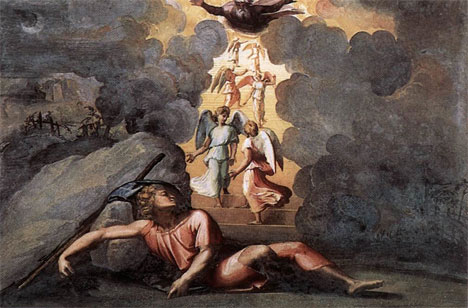
An excerpt from Bible Matrix III:
Just as Esau was the line of Cain rolled into one, so Jacob was a true son of God. In fact, being blameless as Noah was, the Lord granted him a vision of the true Gate of God, a tower reaching to heaven.
In Bible Matrix, we mentioned the significance of Jacob’s “ziggurat” vision as it relates to the mountain of God. [1] Jacob was laid out on the ground like Adam. His slumber brings a “Bridal” vision.
Continue reading
Comments Off | tags: Baptism, Bible Matrix III, Cain, Esau, Genesis, Jacob, Literary Structure, Tabernacle | posted in Bible Matrix, Biblical Theology



































